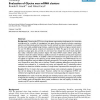Free Online Productivity Tools
i2Speak
i2Symbol
i2OCR
iTex2Img
iWeb2Print
iWeb2Shot
i2Type
iPdf2Split
iPdf2Merge
i2Bopomofo
i2Arabic
i2Style
i2Image
i2PDF
iLatex2Rtf
Sci2ools
BMCBI
2005
2005
Evaluation of Glycine max mRNA clusters
Background: Clustering the ESTs from a large dataset representing a single species is a convenient starting point for a number of investigations into gene discovery, genome evolution, expression patterns, and alternatively spliced transcripts. Several methods have been developed to accomplish this, the most widely available being UniGene, a public domain collection of gene-oriented clusters for over 45 different species created and maintained by NCBI. The goal is for each cluster to represent a unique gene, but currently it is not known how closely the overall results represent that reality. UniGene's build procedure begins with initial mRNA clusters before joining ESTs. UniGene's results for soybean indicate a significant amount of redundancy among some sequences reported to be unique mRNAs. To establish a valid non-redundant known gene set for Glycine max we applied our algorithm to the clustering of only mRNA sequences. The mRNA dataset was run through the algorithm using...
BMCBI 2005 | ESTs | Gene | Initial MRNA Clusters |
| Added | 15 Dec 2010 |
| Updated | 15 Dec 2010 |
| Type | Journal |
| Year | 2005 |
| Where | BMCBI |
| Authors | Ronald L. Frank, Fikret Erçal |
Comments (0)

